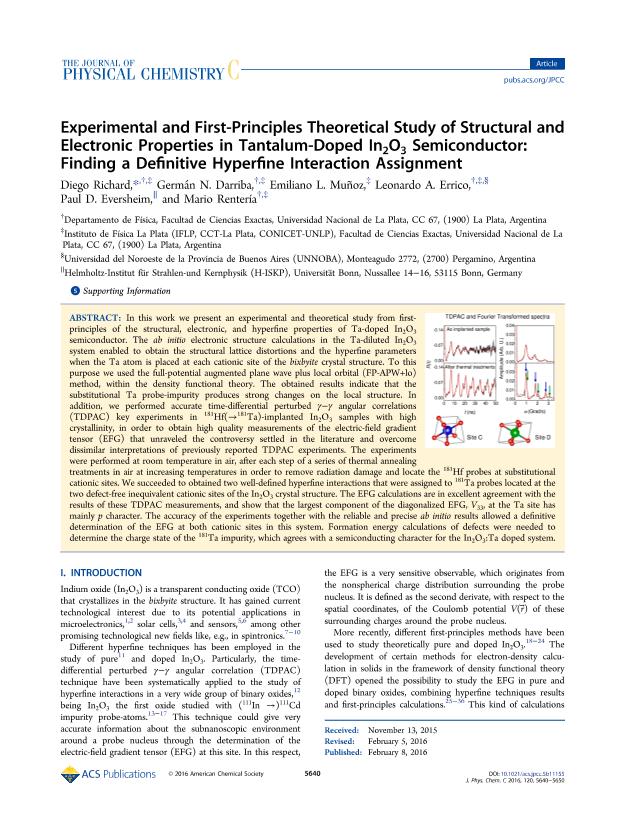Mostrar el registro sencillo del ítem
dc.contributor.author
Richard, Diego

dc.contributor.author
Darriba, German Nicolas

dc.contributor.author
Muñoz, Emiliano Luis

dc.contributor.author
Errico, Leonardo Antonio

dc.contributor.author
Eversheim, Paul D.
dc.contributor.author
Rentería, Mario

dc.date.available
2019-03-25T22:05:13Z
dc.date.issued
2016-03
dc.identifier.citation
Richard, Diego; Darriba, German Nicolas; Muñoz, Emiliano Luis; Errico, Leonardo Antonio; Eversheim, Paul D.; et al.; Experimental and First-Principles Theoretical Study of Structural and Electronic Properties in Tantalum-Doped In2O3 Semiconductor: Finding a Definitive Hyperfine Interaction Assignment; American Chemical Society; Journal of Physical Chemistry C; 120; 10; 3-2016; 5640-5650
dc.identifier.issn
1932-7447
dc.identifier.uri
http://hdl.handle.net/11336/72496
dc.description.abstract
In this work we present an experimental and theoretical study from first-principles of the structural, electronic, and hyperfine properties of Ta-doped In2O3 semiconductor. The ab initio electronic structure calculations in the Ta-diluted In2O3 system enabled to obtain the structural lattice distortions and the hyperfine parameters when the Ta atom is placed at each cationic site of the bixbyite crystal structure. To this purpose we used the full-potential augmented plane wave plus local orbital (FP-APW+lo) method, within the density functional theory. The obtained results indicate that the substitutional Ta probe-impurity produces strong changes on the local structure. In addition, we performed accurate time-differential perturbed γ-γ angular correlations (TDPAC) key experiments in 181Hf(→181Ta)-implanted In2O3 samples with high crystallinity, in order to obtain high quality measurements of the electric-field gradient tensor (EFG) that unraveled the controversy settled in the literature and overcome dissimilar interpretations of previously reported TDPAC experiments. The experiments were performed at room temperature in air, after each step of a series of thermal annealing treatments in air at increasing temperatures in order to remove radiation damage and locate the 181Hf probes at substitutional cationic sites. We succeeded to obtained two well-defined hyperfine interactions that were assigned to 181Ta probes located at the two defect-free inequivalent cationic sites of the In2O3 crystal structure. The EFG calculations are in excellent agreement with the results of these TDPAC measurements, and show that the largest component of the diagonalized EFG, V33, at the Ta site has mainly p character. The accuracy of the experiments together with the reliable and precise ab initio results allowed a definitive determination of the EFG at both cationic sites in this system. Formation energy calculations of defects were needed to determine the charge state of the 181Ta impurity, which agrees with a semiconducting character for the In2O3:Ta doped system.
dc.format
application/pdf
dc.language.iso
eng
dc.publisher
American Chemical Society

dc.rights
info:eu-repo/semantics/openAccess
dc.rights.uri
https://creativecommons.org/licenses/by-nc-sa/2.5/ar/
dc.subject
In2o3
dc.subject
181ta
dc.subject
181hf
dc.subject
Semiconductor
dc.subject
Efg
dc.subject
Hyperfine Interactions
dc.subject
Tdpac
dc.subject
Apw+Lo
dc.subject
Ab Initio
dc.subject
Dft
dc.subject.classification
Otras Ciencias Físicas

dc.subject.classification
Ciencias Físicas

dc.subject.classification
CIENCIAS NATURALES Y EXACTAS

dc.title
Experimental and First-Principles Theoretical Study of Structural and Electronic Properties in Tantalum-Doped In2O3 Semiconductor: Finding a Definitive Hyperfine Interaction Assignment
dc.type
info:eu-repo/semantics/article
dc.type
info:ar-repo/semantics/artículo
dc.type
info:eu-repo/semantics/publishedVersion
dc.date.updated
2019-03-18T15:07:43Z
dc.journal.volume
120
dc.journal.number
10
dc.journal.pagination
5640-5650
dc.journal.pais
Estados Unidos

dc.journal.ciudad
Washington
dc.description.fil
Fil: Richard, Diego. Consejo Nacional de Investigaciones Científicas y Técnicas. Centro Científico Tecnológico Conicet - La Plata. Instituto de Física La Plata. Universidad Nacional de La Plata. Facultad de Ciencias Exactas. Instituto de Física La Plata; Argentina
dc.description.fil
Fil: Darriba, German Nicolas. Consejo Nacional de Investigaciones Científicas y Técnicas. Centro Científico Tecnológico Conicet - La Plata. Instituto de Física La Plata. Universidad Nacional de La Plata. Facultad de Ciencias Exactas. Instituto de Física La Plata; Argentina
dc.description.fil
Fil: Muñoz, Emiliano Luis. Consejo Nacional de Investigaciones Científicas y Técnicas. Centro Científico Tecnológico Conicet - La Plata. Instituto de Física La Plata. Universidad Nacional de La Plata. Facultad de Ciencias Exactas. Instituto de Física La Plata; Argentina
dc.description.fil
Fil: Errico, Leonardo Antonio. Consejo Nacional de Investigaciones Científicas y Técnicas. Centro Científico Tecnológico Conicet - La Plata. Instituto de Física La Plata. Universidad Nacional de La Plata. Facultad de Ciencias Exactas. Instituto de Física La Plata; Argentina
dc.description.fil
Fil: Eversheim, Paul D.. Universitat Bonn; Alemania
dc.description.fil
Fil: Rentería, Mario. Consejo Nacional de Investigaciones Científicas y Técnicas. Centro Científico Tecnológico Conicet - La Plata. Instituto de Física La Plata. Universidad Nacional de La Plata. Facultad de Ciencias Exactas. Instituto de Física La Plata; Argentina
dc.journal.title
Journal of Physical Chemistry C

dc.relation.alternativeid
info:eu-repo/semantics/altIdentifier/url/http://pubs.acs.org/doi/abs/10.1021/acs.jpcc.5b11155
dc.relation.alternativeid
info:eu-repo/semantics/altIdentifier/doi/http://dx.doi.org/10.1021/acs.jpcc.5b11155
Archivos asociados
